Excerpts from Jim Conrad's
Naturalist Newsletter
from the June 12, 2011 Newsletter issued from Mayan Beach Garden Inn 20 kms north of Mahahual; Caribbean coastal beach and mangroves, ~N18.89°, ~W87.64°, Quintana Roo state, MÉXICO
A WILD YELLOW-OLEANDER
We've looked at the Yellow Oleander, Thevetia peruviana, often planted along streets and around people's houses in much of tropical America. It's at www.backyardnature.net/yucatan/y-oleand.htm.
Along our sandy roadsides there's a very common, dense and much-branched bush getting 12 feet or so high (3.6m). It's a native, different species of yellow-oleander, THEVETIA GAUMERI. You can see it below:

Its yellow, funnel-shaped flowers are very similar to the much-planted Yellow Oleander, as shown below:

Our sandy-road yellow-oleanders have fruits similar to those of the planted species, and when mature turn red as well. Nowadays they're still green, though, as seen below:
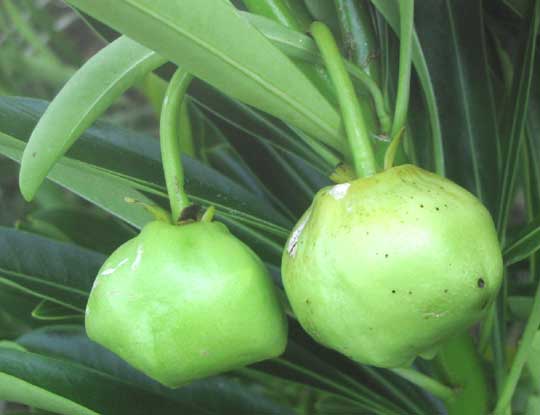
So, the neat thing about our wild yellow-oleander is that it's so similar to the famous, much-planted Yellow Oleander, but it's just a different species, one hardly anyone knows about. Our species specializes in coastal scrub from the Yucatan south to Costa Rica.
Both yellow-oleander species are member of the Dogbane Family, the Apocynaceae, and as is typical of that family they ooze milky, sticky latex when injured. Of course the Maya have noticed this and use the latex medicinally in many ways -- for everything from boils to snakebite, for holding cut skin together, for mange and inflamed skin, to keep down infection, on and on.
from the May 17, 2018 Newsletter issued from Rancho Regenesis in the woods ±4kms west of Ek Balam Ruins; elevation ~40m (~130 ft), N~20.876°, W~88.170°, central Yucatán, MÉXICO
"WILD" YELLOW-OLEANDER'S INLAND FACE
Prettily littering the ground of the one-lane dirt trail on which each morning I jog through the woods,were several yellow, familiar-looking blossoms, as shown below:
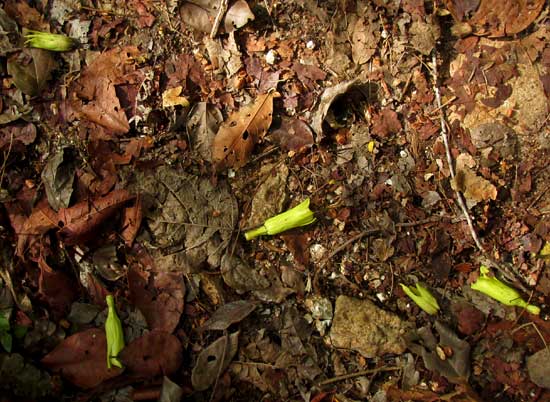
These looked like blossoms of a wild-growing yellow-oleander species we'd looked at along sandy roads paralleling the beach on the Yucatan's Caribbean coast {see above}, but small trees were much branched and formed dense walls along the road, but no such Yellow-Oleander walls were present here. These blossoms were falling from a single, tall, slender, rather spindly tree snaking up through a host of other trees and vines, all competing for sunlight. Maybe this was another Yellow-Oleander species...
"Doing the botany," I broke open a flower lengthwise, and saw the typical yellow-oleander flower structure shown below:
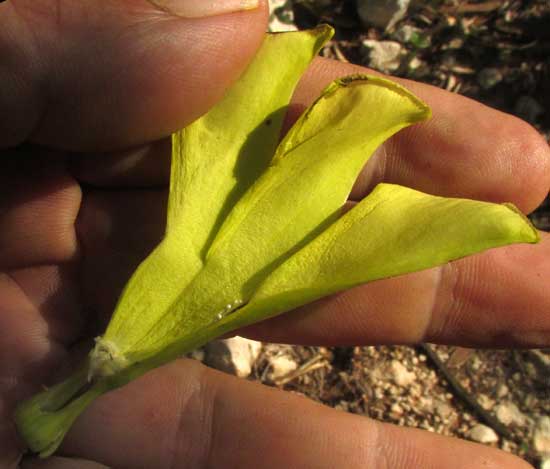
In that picture, the much-reduced stamens are in the shadows at the very bottom. Below, you see a closeup of them:

The anthers are very distinctive. Notice how each stamen's anthers consist of two cells that release their pollen through side openings, and between and above the two cells a pointy, cap-like appendage arises. The stamens in the picture arise at the mouth of the narrow corolla tube, and that opening is lined with many slender, white hairs bending downward. This means that if a pollinator is attracted into the narrow corolla tube by nectar fragrance in the tube's bottom, it'll have a hard time getting out, needing to push against the points of sharp hairs. Having to tarry in the tube, the pollinator is more likely to deposit pollen it's carrying from other flowers.
All these flower features are just like those seen on the Caribbean coast yellow-oleanders, just that the plant bodies bearing the flowers are radically different. However, on Sunday's bike trip to Temozón to buy fruit the same kinds of flowers turned up on tall trees along the road. Below, you can see one starting out below either unbranched or with only a few branches, amid a shaded jumble of other close-pressing trees, bushes and vines, but vigorously branching higher up when it reaches sunlight:
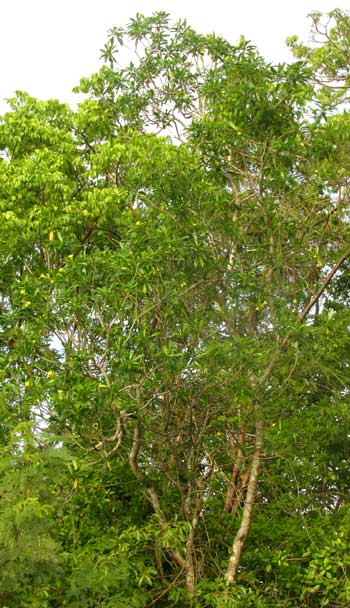
That tree's upper branches bearing flowers and immature green fruits are seen below:
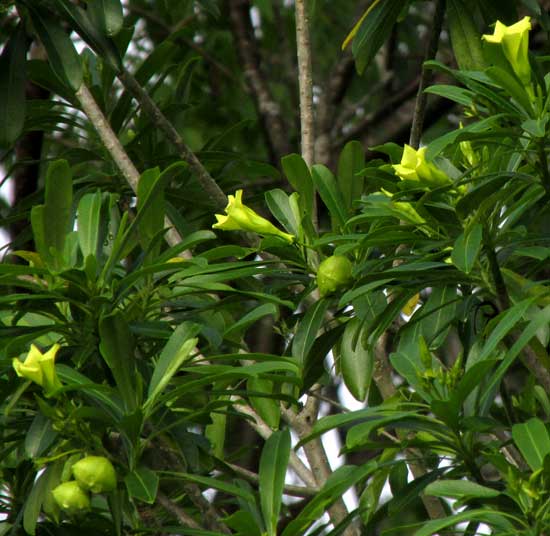
Still thinking this might be a second Yellow-Oleander species, I was surprised when I couldn't find a second species with such flowers listed for the Yucatan. So, they're the same thing, just that their vegetative appearance differs depending on environment.
When we met wild Yellow-Oleanders on the Caribbean, we called them Thevetia gaumeri. Now most authorities appear to have shifted the species to a new genus, calling it CASCABELA GAUMERI. However, the situation is controversial, with some authors including Cascabela within Thevetia, while others accept the two genera as separate. CICY's "Flora of the Yucatan" project now places the species in Cascabela, so that's what I'll use here.
In a paper proposing the separation of the two genera based on morphology, the reasons seem scant to me. They write, "... digitiform suprastaminal appendages and embryos not compressed in Cascabela; reniform fruits and segmented endocarp in Thevetia... "